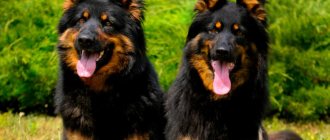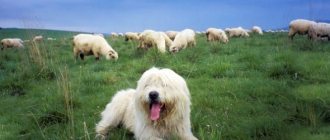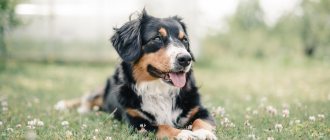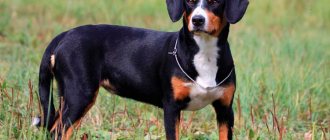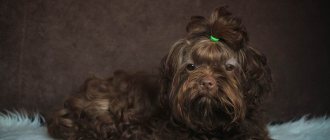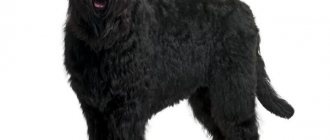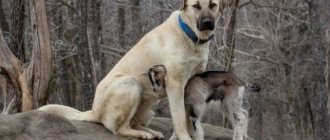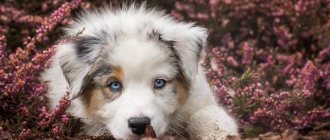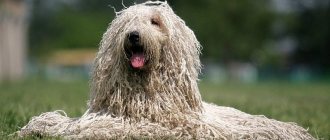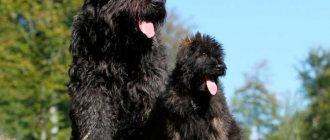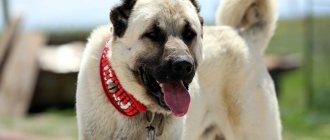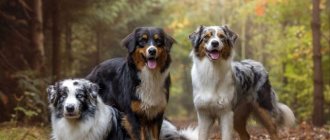brief information
- Country: Netherlands.
- FCI class: Shepherd dogs (herding and cattle dogs)
- Use: service dog, watchman, shepherd, companion.
- Color: brindle and its shades, gray-blue, fawn.
- Lifespan: 12-15 years
- Average weight: 29-30.5 kg.
- Height at the withers: females – 55-60 cm, males – 57-62 cm.
- Price: 35,000-60,000 rubles.
Photo: pxhere.com
Description of the breed
The Dutch Shepherd is a fairly large dog. By adulthood it grows up to 60 cm and has a fit and strong physique. It has a recognizable brindle color of various shades, but there are fawn and gray-blue specimens. There are three types of herder:
- wire-haired;
- short-haired;
- long-haired
The latter type is practically never found today. The Dutch Shepherd is loved by people not only for its beautiful appearance, but also for its abilities. This is a smart dog, distinguished by attentiveness and developed intelligence. Loves long, exhausting physical activity, suitable for keeping in an apartment.
Photo: pixabay.com
Standard
Modern breed standards were established in 1955. At exhibitions, the dog is evaluated according to the following parameters:
- Frame. The body is proportional, muscular and flexible. The body should be strong, but not heavy. It is necessary to have a powerful chest, due to which the animal is able to maintain breathing during intense physical exertion.
- Limbs. The paws are strong and muscular, the bones are well developed. Ligaments must be flexible and elastic. The angle between the thigh and the lower leg is obtuse, due to which the croup is slightly full. The hock joint is positioned so that the metatarsus has a vertical stance.
- The head is proportional to the body. The muzzle is dry and long, normally its length is approximately the same as the skull. In long-haired representatives it seems more massive. The ears are erect and set high. The shells are triangular in shape, pointed and directed forward. The eyes are medium in size, almond-shaped and black in color. Scissor bite.
- Wool. Coat standards differ depending on the breed subtype. In long-haired shepherd dogs, it is straight and long, with a well-developed undercoat. The ears are without fringe, and the hair on the hind legs, head and neck is short. Wirehaired Herders have short, tousled hair all over the body except the face. The beard, mustache and eyebrows stand out well. We accept bluish, motley, fawn and brindle colors.
- Tail. Shouldn't be very long. At rest, the shepherd holds its tail, a slight deflection is acceptable. When moving, it rises higher; falling to the side is unacceptable.
Dogs with white spots on the body and without a mask on the face are not allowed for breeding. The rounded and folded tips of the ears are considered a serious drawback. Males must have two prominent testes, fully descended into the scrotum. Cryptorchids are rare among representatives of this breed.
Distinctive features
Herderhunders, according to the established FCI standards, must meet the following requirements:
- The head is slightly elongated, wedge-shaped, dry, the skull is flattened, the stop is not clearly defined.
- The nose is exclusively black.
- The lips fit tightly, slightly covering the lower jaw.
- Bite – scissors, 42 teeth included.
- The eyes are almond-shaped, not very large, and located at a distance from each other. The color is deep brown, with a black outline.
- The neck is of medium length, dry, with a smooth transition to the shoulder blades.
- The ears are triangle-shaped, long, and set high. Rounded or crooked ones are considered defective.
- The tail is longer than average, straight or slightly curved.
- The body is light, lean, the spine and lower back are straight. The length is slightly greater than the height. The sternum is narrow but deep.
- The legs are muscular, light, moderately angulated. The paw pads are dark, the nails are only black.
Wool can be of 3 types:
- Long (rare variety). Approximately the same expression throughout the body (except for the muzzle, paws, ears, surface below the hock joint on the hind legs), rough. The color is brindle or pure black (gray hair and silver tint are acceptable).
- Tough . The hair is very densely packed, close, looks disheveled, with a good undercoat. The mustache, beard, eyebrows are clearly visible on the face, and the “pants” on the hind legs are pronounced. Color brindle, pepper and salt, gray-blue.
- Short (most common). The hair is hard, with a dense undercoat, the “collar” and “pants” are pronounced, the tail is heavily pubescent. Tiger color.
Character and behavioral characteristics
Like all herding dogs, the Dutch Shepherd is distinguished by its balance and calm character. There may be distrust of strangers, he treats animals with restraint and friendliness, and does not attack without reason. She has strong guard skills and is capable of protecting people and property. The Herder has well-developed attention, keen hearing, vision and excellent reactions. In a number of countries, the breed is used for service work, as a guide dog.
Does not show aggression towards others without reason; with proper upbringing, he unquestioningly obeys his master. This is a very loyal dog that does not tolerate loneliness. Even from puppyhood, the Herder should be trained to remain alone. Gets along well with children, becoming a real member of the family.
History of the origin of the species
The breed appeared in the 19th century. with random crosses of local herding dogs with the Belgian Shepherd (Malinois). There was no goal to breed an animal with a certain appearance; the emphasis was on selection for working qualities. The dogs helped drive the cattle, protected them from predators, and made sure that the sheep did not trample the crops.
The dogs of those times were different from each other, and there was no clear separation from the Malinois.
Since 1860, the breed has been given the name “Herder”, meaning “shepherd”. In 1874, at an exhibition in the capital of the Netherlands, the first more or less similar animals were presented under the name “local shepherd dog”.
But only 4 years later, after the next show in front of the public, the standard and name of the breed were adopted, an amateur club was organized, and a stud book was opened, in which 17 individuals were listed. The new name, Hollandse Herdershond, translated as "Dutch Shepherd" or "Dutch Cattle Dog" .
Despite its exceptional performance characteristics and balanced character, the breed has not received wide recognition because... Around that time, German Shepherds came onto the scene, with the same qualities, but also with a beautiful, memorable appearance. The exterior of Herders has never been a subject of interest for shepherds and farmers.
Dogs, with the disappearance of flocks of sheep, become guards of housing and owners, and in the 20th century they are used to serve in law enforcement agencies. Animals of this breed were officially recognized by the FCI in 1960. They have the following informal names: Dutch, Danish, local shepherd, Herderhunder.
In Russia, the first Herder puppies from American imported parents appeared in 2013. At the moment, there are no more than 10 breeders in the country, the number of dogs is small.
Education and training
The Dutch Shepherd needs early training and education. Socialization can begin as early as 3 months. Even if you do not plan to use the dog for work, when raising you need to pay attention to the following points:
- pay sufficient attention to physical activity - without it, the animal may exhibit destructive behavior or become lethargic. Endurance classes (agility) and running are recommended;
- security skills require constant monitoring and correction. The puppy must be trained not to pay attention to sharp sounds, other people and animals, or the doorbell;
- Aggression towards people and animals is unacceptable. The Herder is very loyal to its owner and can begin to protect even when there is no need for it, so it is important to teach it to hear and follow commands.
The disadvantage of the breed is that the dog does not tolerate loneliness well. May start barking and whining when left alone. With proper training, the Herder becomes an excellent companion; you can take him with you on trips, vacations and outdoor sports.
Characteristics of the Dutch Shepherd Herder
| Attachment level | High |
| Friendliness | High |
| Child Friendly | High |
| Possibility of keeping with other animals | High |
| Exercise needs | High |
| Playfulness | Average |
| Energy level | High |
| Learning ability | High |
| Intelligence | High |
| Tendency to bark | Average |
| Shedding amount | High |
Walks
The dog needs regular and sufficient physical activity. This is important for maintaining your pet's health and fitness. Walks are required at least 2 times a day, the optimal total duration is 2-3 hours. The shepherd quickly learns to walk next to you and, because of its devotion, rarely runs off the leash. It is advisable to provide daily running load, systematically engage in commands that require intellectual tension. The Dutch Shepherd loves to chase a ball, disc or stick - this can be used as an exercise for endurance and speed.
Photo: pixabay.com
Unofficial type of Dutch X
In its homeland in the Netherlands, there is an unofficial type of shepherd dog, the ancestor of which was service animals, without a pedigree. All representatives were bred solely for reasons of improving the working qualities of the dog, a sufficient amount of different blood has accumulated in them, they are officially recognized as a crossbreed.
Possessing ideal performance characteristics gives them the opportunity to exist without recognition by pedigree.
Diseases
The Dutch Shepherd does not have any serious hereditary diseases. A common problem for Herders is hip dysplasia. To avoid this disease in your pet, it is important to request pictures of the litter's parents. As a rule, large breeders and nurseries do them before planned mating.
With illiterate care and maintenance, there is a risk of bedsores and alopecia. In old age, dogs often experience decreased vision and develop cataracts or blindness. The lifespan of a shepherd dog can be up to 15 years. Like other breeds, puppies require routine vaccinations starting at 2 months.
What diseases are Herders prone to, and how long do they live?
The Dutch are extremely healthy dogs. They are not characterized by specific diseases from which other types of shepherd dogs suffer (epilepsy, joint dysplasia, tympanitis, etc.).
The first health difficulties begin in Herders at the age of 10 (with a total life expectancy of 16 years, this is very old age). Such ailments are mostly degenerative in nature and have nothing to do with the dog’s heredity. Thus, the gradual wear and tear of a shepherd’s body most often leads to:
- problems in the cardiovascular system;
- lameness resulting from damage to the articular apparatus or the death of part of the nerve endings involved in the movement of the paws;
- development of cancerous tumors;
- endometritis (inflammation of the uterus) in unsterilized, breeding bitches.
Estrus
In the Dutch Shepherd, the first heat occurs between the ages of 6 and 11 months. Normally, it lasts from 20 to 23 days, and then repeats with regularity up to 2 times a year. The dog's behavior and habitual way of life changes. The bitch becomes more lethargic or active, and her appetite changes. The main sign of the onset of estrus is increased urination and an increase in the size of the labia. During this period, all walks should only be on a short leash. It is advisable to wear special underpants indoors to make caring for your pet and cleaning up during discharge easier.
Mating
It is recommended to plan the first mating of a Dutch Shepherd in the second year of life - by this time the body and reproductive organs will be fully formed. The optimal period for carrying out the process is 10-12 days of estrus. Veterinarians recommend taking a special test to determine the condition of the eggs.
You need to select a pair for a herder based on height and weight. The male should be slightly smaller than the female. This allows you to avoid problematic births and caesarean sections. Both representatives of the breed must match in color, which is important to preserve the exterior characteristics. Acquaintance can be carried out both on the territory of a male and a female. It is important to provide comfortable conditions, since the dog is alert even when not in heat. Control mating is permissible no earlier than 24 hours after the first one.
Kelpie
Australian Aboriginal breed. The height of an adult is from 44 to 52 cm, weight is from 12 to 19 kg. The Kelpie's special feature is its wide viewing angle. Thanks to this, the dog has the opportunity to observe a huge number of animals grazing in the meadow, and make sure that none of them gets lost. Yes, he is classified as a herder.
This is a very hardy animal that is able to walk a huge distance without getting tired. He can carry a heavy load. One of the Kelpie's best skills is running fast. The breed is loud and energetic. He loves to spend active time with his owner.
It is distinguished from other four-legged pets by its intelligence. Such a dog cannot be called selfish, but he is moderately self-confident and proud. Needs a special educational approach. Types of colors of the Australian Kelpie Shepherd: gray, red, brown, black.
Pregnancy
The gestation period for Shepherds varies from 50 to 56 days. During this time, the animal should be provided with high-quality and balanced nutrition, and serious physical and psychological stress should be avoided. The litter of this breed is small - 4-6 puppies; the first time a female produces fewer offspring. It is advisable to carry out childbirth only under the supervision of a veterinarian in order to avoid unpleasant consequences and carry out the necessary resuscitation measures in a timely manner.
The Dutch Shepherd has good maternal instincts. After giving birth, the bitch's guarding skills may become more acute. To prevent such changes, ensure that your pet is kept in a comfortable and quiet environment during this period.
Photo: wikimedia.org
Care
Herder does not require complex care. When working with a breed, it is important to take into account the characteristics of the coat, content and age. Recommendations for caring for a Dutch Shepherd:
- monthly inspect the ears, clean wax accumulations;
- in the summer, the claws grind down on their own; in the winter, they should be trimmed every month;
- check the condition of the eyes, clean them from dirt. If necessary, use special veterinary drops;
- How often you brush your teeth depends on your age and diet. When drying, the procedure is carried out less frequently than when drying. The optimal frequency of cleaning by a veterinarian is once a year. For prevention, allow chewing on dense treats, use a special paste;
- Hair care varies depending on its type. Brushing should be done weekly, especially during shedding periods. Only long-haired dogs need a haircut. Wire-haired representatives of the breed are trimmed 2-3 times a year, show dogs are plucked monthly;
- bathing is necessary 2-3 times a year; if the dog lives in an apartment, the procedure can be performed more often.
The pet should have its own place in the house, for example, a bed without sides. It is recommended to purchase only metal bowls, with the ability to adjust the stand to the height of the dog.
Photo: maxpixel.net
How to position the ears
Raised ears are a key feature of the breed and a prerequisite for exhibition. They are specially placed in puppyhood. A simple way to put ears on a Dutch Shepherd:
- Treat the sinks with a cotton pad soaked in hydrogen peroxide or Chlorhexidine.
- Place your ears vertically and place an ice cream stick or similar object made of natural materials nearby.
- Tape them with medical tape, creating a bridge between the ears.
Change the patch and sticks every 4-7 days or when soiled. With this method, the puppy’s ears stand up after 3-4 weeks. During this time, give vitamin and mineral supplements rich in calcium.
How to position the ears
It is not always the case that a pet’s ears automatically take on the “upright” position; sometimes the owner has to apply force to achieve this. So, to set up the ears you will need:
- ice cream sticks;
- patch;
- soft curlers.
Before starting the process, you need to prepare the ears, namely treat them with peroxide or alcohol-based lotion, but the liquid should not get inside the ear. Using a patch, you need to attach the stick to the base of the ear, securing the jumper between them.
Jumpers and sticks need to be changed several times a week, especially if they get wet. Using this method, your pet's ears stand up in 3-4 weeks.
Feeding
Dutch Shepherds are not picky eaters. They adapt to both natural nutrition and dry food. They will benefit from an active breed diet rich in protein and carbohydrates. They rarely suffer from allergies, so the ingredients are selected depending on the pet’s taste preferences. The feeding regime of puppies and their diet differs from adults. At the age of up to 6 months, the dog should be fed every 3-4 hours, then switched to the classic mode - 2-3 times a day.
Photo: wikimedia.org
Tips for choosing puppies
You can wean a puppy from its mother at the age of 2-3 months. They quickly socialize and get used to their owner. When choosing a pet, pay attention to appearance and behavior. The dog must be active and curious; it is not recommended to purchase frightened, confused puppies. You should check the condition of the coat - it should be uniform, without white spots or signs of alopecia. The limbs of a healthy individual are mobile, without pronounced markings. Check the presence of all documents for the litter, ideally - x-rays of the parents for the absence of dysplasia.
Flaws
Disadvantages include physical and mental deviations from the standard; if they do not affect the quality of life, then the pet will live a long and happy life, but without participation in exhibitions and access to breeding.
The most common of them:
- Lack of uniform color, presence of white spots in large quantities;
- Preventing the testicles from entering the scrotum in male dogs;
- Lack of correct bite, misalignment of the jaw, lack of a full set of teeth or fangs, crooked front teeth;
- Unpainted eyelids, nose or lips;
- Insufficient color of the iris;
- Too large or small bone;
- Distortion of the lower back, shoulder, back;
- Short back, neck, lower back;
- Insufficiently developed muscles, low weight;
- Slanted croup;
- Too wide and large head;
- Light cartilage, recumbent ears;
- Mental disorders - cowardice, aggression;
- Tail crease;
- Round chest;
- Neck too long;
- Different eye colors;
- No black mask;
- Scanty wool.
Owner reviews
Arkady K. “We found a Dutch Shepherd puppy in France. Zhora has been living with us for 5 years. During this time we faced various difficulties. It was difficult to stop him from barking in the apartment and chewing furniture. With age, the song has calmed down a little, but if you don’t take a good walk, it can be too active.”
Anna E. “I have long dreamed of owning a Herder. I was looking for a puppy for a long time, the choice fell on a brindle girl. This is a very smart, beautiful and loyal dog. I spend a lot of time with her, doing agility. I believe that the breed has no disadvantages.”
